Scratchbuilt 1/72 BOK-5 1937By Gabriel Stern |
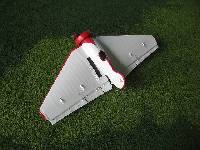 The
use of radial engines in small airframes tends to create very cartoon-like shapes
of an undeniable appeal.
The
use of radial engines in small airframes tends to create very cartoon-like shapes
of an undeniable appeal.
Some of these stumpy, chubby, cute little bugs are well known (like the Gee-Bee
racers or the Polikarpov I-15) while others are more obscure subjects. If this
type of design was a monoplane (like the Bristol Type 72 Racer or the Polikarpov
I-16), then the effect was even more notorious; but if on top of that we have
a “flying wing” example, then the resulting aesthetics are just
as fun as they are attractive.
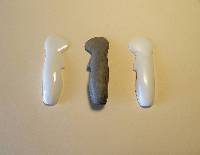 The
BOK-5 was a Russian design proposal originated –as the designation states-
at the Bureau of Experimental Aircraft (Buro Osovikh Konstruktsii) and the project
was led by V. A. Chizhevsky. It had a Mikulin M-11 as its power plant and a
span of less than 10 meters. It had metal structure and the flying surfaces
were mostly fabric-covered.
The
BOK-5 was a Russian design proposal originated –as the designation states-
at the Bureau of Experimental Aircraft (Buro Osovikh Konstruktsii) and the project
was led by V. A. Chizhevsky. It had a Mikulin M-11 as its power plant and a
span of less than 10 meters. It had metal structure and the flying surfaces
were mostly fabric-covered.
After initial flights and some adjustments the plane revealed itself as a very
good machine, but notwithstanding its virtues didn’t go into production.
The Scupley-made fuselage master fitted comfortably in the Mattel Vac-U-Form
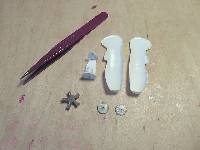 plate
and promptly I had my two fuselage half-shells. The interior was furnished according
to references and then the wing was fabricated out of styrene sheet and rod
as per photos. A sort of Townend ring was created laminating styrene sheet on
a metal tube–see also the images to follow the simple procedure- and an
“Engine ‘n Things” Mikulin was retrieved from deep hibernation
in the spares bin. This particular engine is not the best one I have seen from
this manufacturer, with the back side well detailed and the front side marred
by the area of the cylinders enclosed by the pushrods, which was a pool of resin.
Some pinholes –or potholes- further enhanced the overall results.
plate
and promptly I had my two fuselage half-shells. The interior was furnished according
to references and then the wing was fabricated out of styrene sheet and rod
as per photos. A sort of Townend ring was created laminating styrene sheet on
a metal tube–see also the images to follow the simple procedure- and an
“Engine ‘n Things” Mikulin was retrieved from deep hibernation
in the spares bin. This particular engine is not the best one I have seen from
this manufacturer, with the back side well detailed and the front side marred
by the area of the cylinders enclosed by the pushrods, which was a pool of resin.
Some pinholes –or potholes- further enhanced the overall results.
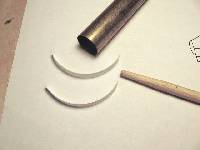 Wing
and fuselage were mated, but no eggs were laid. Details on the fuselage were
added and then the under-hanging control surfaces for the wing. Wheels came
from Aeroclub and landing gear structure was a combination of assorted bits.
Last details were the home-made wooden prop and a number (14) of photoetched
control horns, which amused my ears with the “ping” sound they made
every time they jumped to hyperspace from the tweezers.
Wing
and fuselage were mated, but no eggs were laid. Details on the fuselage were
added and then the under-hanging control surfaces for the wing. Wheels came
from Aeroclub and landing gear structure was a combination of assorted bits.
Last details were the home-made wooden prop and a number (14) of photoetched
control horns, which amused my ears with the “ping” sound they made
every time they jumped to hyperspace from the tweezers.
Finishing presented a dilemma. The original color was apparently either white
or light 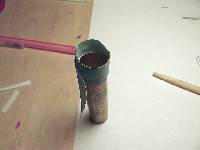 grey,
but I think that aluminum is a possibility as well. Some color reported as red
–which will make sense being this a Russian plane- was applied to the
nose ring, leading edges and to some trim lines on the upper fuselage. But for
the annual parade a very original and psychedelic scheme was applied, a la Kalinin
K-12 “Zhar Ptitsa”.
grey,
but I think that aluminum is a possibility as well. Some color reported as red
–which will make sense being this a Russian plane- was applied to the
nose ring, leading edges and to some trim lines on the upper fuselage. But for
the annual parade a very original and psychedelic scheme was applied, a la Kalinin
K-12 “Zhar Ptitsa”.
This artistic scheme is represented in different ways by several sources. The
usual heavily retouched Russian photos duplicated with hectographic gelatin
in the cold basement of a Buro (http://en.wikipedia.org/wiki/Hectograph) did
not help. That made me lean towards the original scheme.
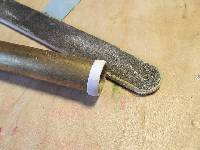 Few
decals for this one: only the concentric circles for the wheels and the BOK
triangular logo for the rudder.
Few
decals for this one: only the concentric circles for the wheels and the BOK
triangular logo for the rudder.
Za Rodina!
Lost and Found:
Fellow modeler Lars Opland lost his tweezers somewhere over his building board.
If anybody see them please call the Lost & Found office at ARC.
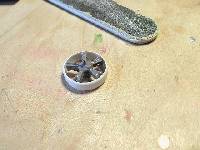 Bibliography:
Bibliography:
-“My Life On The Winged Steps” by Stevensko Kallanovich, People’s
Editors, Novaya-Zemlya, 1937.
-“Oigadoñaya –Memoirs of a Russian Test Pilot Without a Samovar”
by Jimilovich Schuberoff, Kalashnikov Editions, Alma-Ata, 1937.
-“The Varenike That Flew Through The Kitchen’s Roof” by Rosetia
Moylensk, Valentina Tereshkova Publishers, Sakhalin Island, 2009.
-“Greeks Invented the Flying Wing” by Kristophan Psarrasnikoff,
Kojak Editors, Kola Peninsula, 2012.
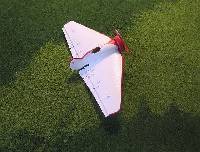 |
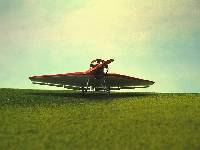 |
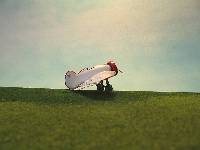 |